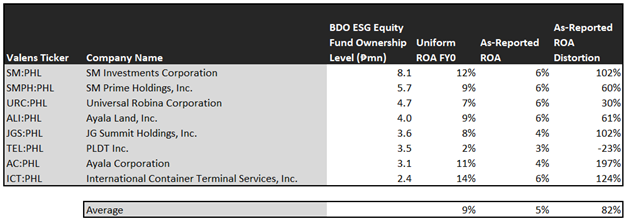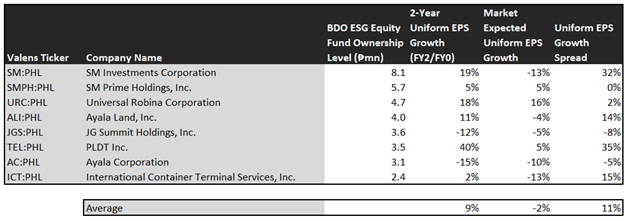This UITF focuses on socially responsible companies, and Uniform Accounting affirms that these companies are economically profitable.

The country’s leading bank is finding ways to provide an array of investment products to its customers and the investing public.
Taking advantage of the growing popularity of environmental, social, and governance (ESG) investing, this bank rolled out the Philippine’s first ever ESG-themed unit investment trust fund (UITF).
As-reported metrics would leave investors confused with the companies in this UITF. However, Uniform Accounting reflects the reality of the companies the fund invests in and how they fit into the firm’s investment philosophy.
In addition to examining the fund’s portfolio, we are including fundamental analysis of one of the fund’s largest holdings, providing you with the current Uniform Accounting Performance and Valuation Tearsheet for that company.
Philippine Markets Daily:
Friday Uniform Portfolio Analytics
Powered by Valens Research
The term “ESG” first appeared in 2005 in the report “Who Cares Wins,” which was published following United Nations’ initiative to examine and integrate ESG in financial analysis, asset management, and brokerage services.
The report argued that considering ESG factors in the investment analysis leads to a better understanding of good business sense, underpins more sustainable markets, and provides better outcomes to stakeholders.
At the same time, the United Nations Environment Program Finance Initiative (UNEP FI) released a report highlighting the relevance of ESG issues to financial valuation.
The reports from the United Nations led to the formation of Principles for Responsible Investment (PRI) in 2006 and the launch of the Sustainable Stock Exchange Initiative (SSEI) in 2007. These two global organizations have led the advancement of ESG analysis and reporting.
ESG investing is the integration of environmental, social, and governance practices of a company into the investment and decision-making processes.
This covers non-financial factors that affect financial performance, such as climate change, waste production, pollution, health and safety, employee relations, quality of management, conflicts of interest, and management transparency and disclosure.
After overcoming initial reluctance due to lack of data and necessary tools, the concept of embedding ESG into financial analysis can improve returns rapidly spread across financial markets in various continents.
According to the Global Sustainable Investment Alliance, ESG investments ballooned from around $13 trillion in 2012 to more than $30 trillion in 2018, and it is expected to continue accelerating as investors demand transparency and social responsibility from business enterprises.
Furthermore, Morningstar reported that in 2019, ESG funds in the United States reached a record $20.6 billion inflows, almost four times the amount recorded in 2018.
In the midst of the growing popularity of ESG investing, Banco De Oro (BDO) Trust and Investments Group started the BDO ESG Equity Fund.
This fund, launched in December 2015, is the first UITF in the Philippines that employs a socially responsible investing strategy. The fund focuses on companies that promote environment protection and community development–factors that help sustain long-term corporate profitability and shareholder value creation.
Looking at the BDO ESG Equity Fund using as-reported figures, it is not obvious that these companies are generating economic profit despite adopting solid ESG practices.
As-reported metrics would have investors believe that this portfolio comprises low-quality firms. However, Uniform Accounting reveals the reality behind these companies.
The table below shows the top non-financial holdings of the BDO ESG Equity Fund along with their Uniform return on assets (ROA), as-reported ROA, and ROA distortion—the difference between Uniform and as-reported ROA.

Several companies in this fund show as-reported ROAs that range around and below global cost-of-capital level, suggesting that they are not generating economic profit. However, Uniform Accounting reveals that most of these companies have strong returns, with Uniform ROA above 6% global average returns except for PLDT Inc. (TEL:PHL).
The Uniform Accounting framework addresses financial statement inconsistencies attributable to the flaws present in the Philippine Financial Reporting Standards (PFRS) to determine the true underlying performance of companies and avoid distorted financial analysis and valuation.
As such, it should not be surprising that when analyzing the non-financial holdings of the BDO ESG Equity Fund, the figures that easily stand out are the double-digit discrepancies between Uniform ROA and as-reported ROA for these companies.
While at a glance, the difference between as-reported ROA and Uniform ROA may not seem that great, the distortion in percentage ranges from -23% to 197%, with Ayala Corporation (AC:PHL), International Container Terminal Services, Inc. (ICT:PHL), JG Summit Holdings, Inc. (JGS:PHL), and SM Investments Corporation (SM:PHL) having distortions above a hundred percent.
As-reported ROA understates the profitability of Ayala Corporation, suggesting a below-average firm with an as-reported ROA of 4%. In reality, this is a high-quality company with an 11% Uniform ROA, almost thrice the as-reported number.
In fact, AC, which has been a constituent of the Financial Times Stock Exchange (FTSE) Russell’s FTSE4Good Index of socially responsible companies for four years now, has never generated a Uniform ROA below 10% over the past 15 years.
Similarly, ICT is not just a 6% ROA firm as the as-reported numbers suggest. It is, in fact, a high-quality company with a 14% Uniform ROA.
This port management company adopted the Global Reporting Initiative (GRI) standards in 2017 for the reporting of its sustainability practices and has seen its Uniform ROA improve since then.
There are other companies in the BDO ESG Equity Fund whose profitability is understated by as-reported metrics. However, like AC and ICT, Uniform Accounting shows that they are producing above-average profit.
That said, looking at profitability alone is insufficient to deliver satisfactory investment returns. Investors should also identify if the market is significantly undervaluing the company’s earnings potential.
The BDO ESG Equity Fund is also invested in companies with unreasonably low market expectations.

This table shows the earnings growth expectations for the major non-financial holdings of the fund. It features three key data points:
- The 2-year Uniform EPS growth represents the Uniform earnings growth the company is likely to have for the next two years. The earnings number used is the value of when we convert consensus sell-side analyst estimates to the Uniform Accounting framework.
- The market expected Uniform EPS growth represents what the market thinks Uniform earnings growth is going to be for the next two years. Here, we show by how much the company needs to grow Uniform earnings in the next two years to justify the current stock price of the company. This is the market’s embedded expectations for Uniform earnings growth.
- The Uniform EPS growth spread is the difference between the 2-year Uniform EPS growth and market expected Uniform EPS growth.
On average, Philippine companies are expected to have 6% annual Uniform earnings growth over the next two years. Meanwhile, the BDO ESG Equity Fund’s top holdings are forecast to surpass that with 9% projected Uniform earnings growth in the next two years.
The market, on the contrary, is seeing a decline in earnings for these companies with Uniform EPS shrinkage of 2% over the next two years.
Among these companies, PLDT, SM Investments Corporation, and ICT have the highest Uniform earnings growth dislocation.
The market is mispricing PLDT’s Uniform Earnings to rise by 5% in the next two years. However, sell-side analysts are seeing the telco’s earnings to accelerate by 40% moving forward.
Similarly, the market is seeing SM’s uniform earnings to plunge by 13%, but analysts are projecting a robust 19% earnings growth for the firm in the next two years.
Overall, as-reported numbers would have investors incorrectly conclude that this portfolio consists of low-quality companies with bearish earnings growth expectations. In reality, when viewed under the Uniform Accounting lens, investors can clearly see that BDO ESG Equity Fund’s major non-financial holdings are high-quality companies with above-average Uniform ROA and high single-digit earnings growth potential.
Universal Robina Corporation Tearsheet
Today, we’re highlighting one of the largest individual stock holdings in the BDO ESG Equity Fund—Universal Robina Corporation (URC:PHL)
As our Uniform Accounting tearsheet for URC highlights, it trades at a Uniform P/E of 34.8x, above global corporate averages but below historical averages.
Low P/Es require low EPS growth to sustain them. In the case of URC, the company has recently shown a 26% slump in its Uniform EPS.
Sell-side analysts provide stock and valuation recommendations that poorly track reality. However, sell-side analysts have a strong grasp on near-term financial forecasts like revenue and earnings.
We take sell-side forecasts for PFRS earnings as a starting point for our Uniform earnings forecasts. When we do this, URC’s sell-side analyst-driven forecast shows that Uniform earnings will grow by 19% in 2019 and 18% in 2020.
Based on the current stock market valuations, we can back into the required earnings growth rate that would justify PHP 130 per share. These are often referred to as market embedded expectations.
In order to meet the current market valuation levels of URC, the company would have to see Uniform earnings expand by 16% each year over the next three years. Sell-side analysts’ expected 18% earnings growth for the company surpasses what the current stock market valuation requires.
The company has an earning power slightly above long-run corporate averages—based on its Uniform ROA calculation. Additionally, since the combination of the company’s cash flows and cash on hand consistently exceeds its obligations over the next five years, URC has a low dividend risk.
To conclude, URC’s Uniform earnings growth is above peer averages. Moreover, the company is trading higher than average peer valuations.
About the Philippine Market Daily
“Friday Uniform Portfolio Analytics”
Investors who don’t engage in the buying or selling of securities for a living oftentimes rely on professionals to manage their own investments within the scope of their investment policies.
With so many funds and managers out there, it can get confusing and difficult to decide which one best suits your needs as an investor.
Every Friday, we focus on one fund in the Philippines and take a deeper look into their current holdings. Using Uniform Accounting, we identify the high-quality stocks in their portfolio which may not be obvious using the as-reported numbers.
We also identify which holdings may be problematic for the fund’s returns that they would need to reconsider from a UAFRS perspective.
To wrap up the fund analysis, we highlight one of their largest holdings and focus on key metrics to watch out for, accessible in our tearsheets.
Hope you’ve found this week’s focus on BDO ESG Equity Fund interesting and insightful.
Stay tuned for next week’s Friday Uniform Portfolio Analytics!
Regards,
Angelica Lim
Research Director
Philippine Markets Daily
Powered by Valens Research
www.valens-research.com




